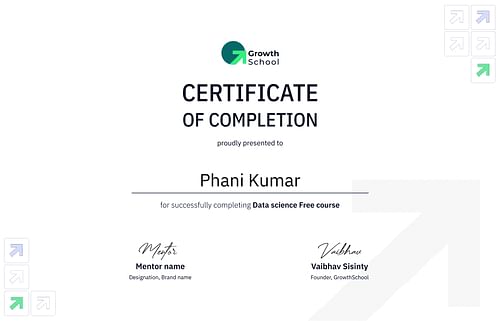Free Product Management Course on Avoiding Product Growth Mistakes
Learn how to avoid common mistakes that hinder your product's growth with our free product management course, The Product Growth Paradox. Enroll now!
Before you ask, we do give certificates!
Get certified upon course completion and supercharge your career journey.

Learning Objectives
1. Enhanced User Onboarding Strategies
Implementing proactive, personalized onboarding processes to drive long-term retention and maximize user success with the product.
2. Long-Term Educational Initiatives
Creating a knowledge-sharing culture by consistently conducting user research, sharing insights, and learnings to improve metrics and foster collaboration across departments.
3. Optimized Growth Metric Tracking
Utilizing customized dashboards to identify growth opportunities, optimize strategies, and align pricing with customer value to enhance revenue and customer satisfaction.
4. Coordinated Growth Team Alignment
Establishing common goals, facilitating communication, and integrating new features thoughtfully to maintain coherence in product messaging and promotions among sales, marketing, and product teams.
Read More
Who's it for
Product Managers
User Experience Designers
Growth Marketers
Customer Success Managers
Business Development Executives
Our Learners love GrowthSchool
What will I learn
Chapter 1
Understanding the Importance of User Onboarding
This chapter delves into the significance of user onboarding in driving long-term retention and monetization. It emphasizes the need for a proactive approach focused on personalized user experiences to enhance product success. The chapter highlights the drawbacks of generic onboarding and advocates for a continuous onboarding process to empower users throughout their interaction with the product.
Chapter 2
Strategies for Long-Term Education and Knowledge Sharing
Long-term education for users is explored here as a key factor in improving metrics and increasing retention rates. The chapter stresses the importance of sharing knowledge and insights across the organization to foster collaboration and avoid repeating mistakes. It also underscores the necessity of consistent user research at various product development stages to address user needs effectively and create user-centric solutions.
Chapter 3
Driving Business Success Through Monitoring Growth Metrics
This chapter focuses on the significance of understanding growth opportunities and tracking key metrics through customized dashboards. It highlights the value of transparent pricing strategies aligned with customer perception of value and effective communication about product features. The concept of viewing growth as a collaborative system among teams is introduced to ensure successful implementation of growth strategies and overall business performance.
Chapter 4
Ensuring Alignment Among Growth Teams
Misalignment among growth teams is discussed in this chapter as potentially hindering progress in product marketing and sales. The importance of regular collaboration between sales, marketing, and product teams is emphasized for maintaining coherence in product messaging and promotions. The chapter advocates for establishing common goals, fostering communication, and integrating new features thoughtfully to drive adoption and value demonstration to end-users.
Chapter 5
Prioritizing User Needs and Collaborative Knowledge Sharing
This chapter highlights the significance of prioritizing user needs, sharing internal knowledge, and fostering collaboration among teams. It stresses the role of continuous user research, sharing learnings, and experimenting results for creating a transparent and collaborative work environment. The importance of integrating insights gained from educational events into immediate framework implementation is encouraged to drive product success and meet user expectations.
Chapter 6
Implementing User-Centric Growth Strategies
The focus of this chapter is on implementing user-centric growth strategies through effective user onboarding, continuous education, and monitoring of growth metrics. It emphasizes the need for strategic initiatives that align with user needs and drive sustainable growth. The chapter underscores the role of understanding user expectations, sharing knowledge internally, monitoring performance metrics, and fostering collaboration in achieving long-term growth and business success.
Chapter 7
Sustainable Growth Through Strategic Initiatives
This chapter emphasizes the importance of adopting a user-centric approach and implementing strategic initiatives for sustainable growth. It highlights the need for prioritizing effective user onboarding, continuous education, monitoring growth metrics, and fostering alignment among teams. The chapter discusses how strategic initiatives can contribute to long-term growth and maximize business success by creating valuable products that meet user expectations.
Meet your Mentor
Viktoria Kharlamova
Growth Advisor @ Freelancer
Viktoria Kharlamova, Partner at Maven, is expertise in Product Growth and Customer Onboarding. She also serves as a Growth Advisor at Rask AI, focusing on Revenue & Profit Growth, Growth Strategies, and Product Growth. With extensive experience, she excels in driving business growth and implementing effective strategies for success.
Frequently Asked Questions
What are the main pillars of Product Management?
The main pillars of Product Management include market research, product development, marketing, and product launch strategies.
What is Product Management, and why is it important to learn about?
Product Management involves overseeing the development and marketing of a product. It's crucial for successful product launches.
Is this Product Management course designed for corporate training and workforce upskilling?
Yes, the Product Management course is ideal for corporate training and to enhance workforce skills in this area.
How long can I access the free product management course content?
You can access the free product management course content for an unlimited period once enrolled.
Will I receive a certification upon completion of the free product management course?
Yes, you will receive a certification upon successful completion of the free product management course.

The Product Growth Paradox How to Avoid the Mistakes That Keep Your Product from Growing
3.5
(262 ratings)
Advanced
Tomorrow, 2:30 pm GMT
19k Learners enrolled
Mentor
Viktoria Kharlamova
Growth Advisor @ Freelancer
Why GrowthSchool?
GrowthSchool is where you become the Top 1% in your field. We bring the best of Product, Growth, Design, Tech, data and business mentors from brands like Google, Meta, Uber etc doing the jobs you want to do tomorrow.
400k+
Total Students
Top Startup India 2024
Backed by the best
and 80+ Angel investors like



What are Free Courses?
Free online courses offer a wealth of knowledge in product, design, growth, and marketing without cost. They provide flexibility for skill enhancement and professional development. Many courses include certificates, bolstering resumes and LinkedIn profiles, demonstrating a commitment to learning and advancement in these dynamic fields.




